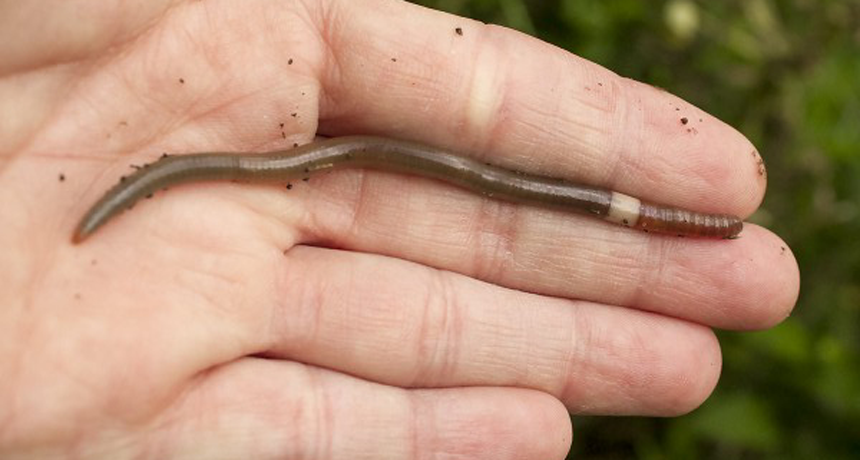Earthworms: Can these gardeners’ friends actually become foes?
Invading jumping worms can remove leaf litter, making it hard for forest plants to grow

The Asian jumping worm can be identified by its distinctive flat, tan band and the way it flops and jumps when disturbed.
UW Arboretum/Susan Day
Invading earthworms! It sounds like the title for a bad Hollywood film, but science can be stranger than fiction.
“They are different from any other earthworm I’ve seen,” says Monica Turner. She is an ecologist who works at the University of Wisconsin-Madison. An ecologist is a scientist who studies the relations of organisms to one another and to their physical surroundings. The unusual worms are known as Asian jumpers, “Alabama jumpers” or “crazy worms.” When disturbed, they not only wriggle and flop, but also can hop off of the ground.
“If you touch them, they move like snakes,” Turner notes. “They also get really big. If you take the width of a pencil and make it six inches [15 centimeters] long, that’s how big they get.”
New research shows that these Earth movers have been invading some American forests. There they boost the breakdown of litter — plant debris on the forest floor. By eliminating this litter too quickly, they are removing the material that many plant seeds need to get their start in life.
Turner and a former student, Jiangxiao Qiu, studied the impact of these worms on soils from Wisconsin forests and prairies.
Normally gardeners and biologists love to see earthworms. That’s because these animals create holes in the soil, making it permeable. Now rains and air can seep through. What’s more, the worms deposit nutrients that plants need to grow. They do this by eating dead vegetation. As a worm’s gut digests these leaves and twigs, it sloughs off nutrients such as nitrogen and phosphorus in its feces. When they poop, the worms leave those nutrients behind.
But Asian jumping worms have bigger appetites than other earthworms found in the United States. They also tend to congregate in large groups. So they chow down on leaf litter especially quickly. Perhaps too quickly, Turner and Qiu now find.
The pair collected soil from both forested and prairie areas in southern Wisconsin. These samples were initially free of the Asian jumping worms. The researchers then divided samples from each area into three plastic cylinders and brought them back to their lab for study.
Each cylinder was 20 centimeters (almost 8 inches) in diameter and 25 centimeters deep. They added six Asian jumping worms to one cylinder. This matches the density at which these worms were measured in a nearby forest.
No Asian jumping worms were added to the second cylinder. It served as the control — something to give researchers an unaltered comparison. Such a control is needed because even without added earthworms, soil microbes and exposure to the weather will break down leaf litter. The control cylinder would identify how much of this natural breakdown occurs.
The researchers took soil from the third cylinder to measure what leaf litter and nutrient levels had been before the experiment had begun. Having this starting point would allow the team to measure how much things had changed.
Four months later, the researchers measured the leaf litter and nutrient levels in the first two cylinders. They compared these to the earlier measurements made of soil in the third cylinder.
Soil containing Asian jumping worms lost 95 percent of its leaf litter during the experiment. The cylinder with no earthworms lost 34 percent of its leaf litter. There also was much more soil nitrogen and phosphorus in the cylinder with the Asian jumping worms.
The researchers published their findings online September 2 in Biological Invasions.
What’s the big deal?
This exaggerated loss of leaf litter by the jumping worms is a problem, says Bernadette Williams. She is a biologist and expert on invasive plants and earthworms. Williams works for the Wisconsin Department of Natural Resources in Madison. Some plants need leaf litter to germinate, she notes. And, she adds, that litter protects the soil beneath.
Think of leaf litter as the forest’s skin, she says. A cut or burn on your skin opens it up to infection. “It’s the same for a forest,” says Williams. “When the worms eat the leaf litter, it breaks a protective layer and opens up the forest to disease and invasive plants.”
Turner and Qiu also found there was much more nitrogen and phosphorus in the cylinder with the worms. Plants need both nutrients to grow. However, as Turner points out, “sometimes you can have too much of a good thing.” High levels can damage a plant. Rains may also wash the nutrients away before the plant is able to use it, contaminating local rivers.
Jumping worms first arrived in North America about a century ago. Scientists suspect they were hitchhikers in the soil surrounding garden plants imported from Asia. But in the 1980s, growers deliberately imported large numbers of them to help break up dense clay soil in Alabama, notes Williams.
The worms now can be found in 20 states, mostly on the East Coast and the Midwest, she says. Williams was one of two researchers who discovered them on the grounds of the University of Wisconsin-Madison Arboretum in 2013.







